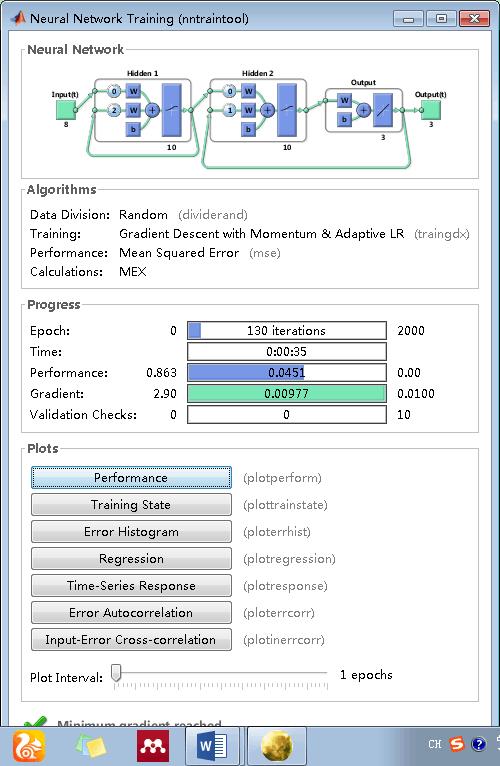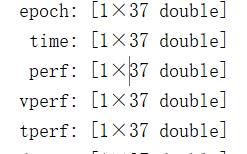matlab中神经网络训练结束后出现nntraintool面板,如何记录此时nntraintool上的performance值和epoch值?
Posted
tags:
篇首语:本文由小常识网(cha138.com)小编为大家整理,主要介绍了matlab中神经网络训练结束后出现nntraintool面板,如何记录此时nntraintool上的performance值和epoch值?相关的知识,希望对你有一定的参考价值。
因为要循环n多次试验,求取平均值,所以不能通过人眼观看的方式来记录这些值,应该使用什么参数可以调用到performance值和epoch值呢?


如上图,把神经网络的格式改成如此,tr是结构体型数据,其中包含performance和epoch的值,可调用,如下图

在 matlab 上配置和训练后,如何使用神经网络运行预测?
【中文标题】在 matlab 上配置和训练后,如何使用神经网络运行预测?【英文标题】:How do I run a forecast with neural network after configuring it and training it on matlab? 【发布时间】:2021-02-16 15:25:50 【问题描述】:我使用 nnstart 命令并获得了一个用于配置和训练网络的 matlab 应用程序。导入数据并训练网络后,我无法选择实际运行时间序列预测。我能做的最好的事情是我可以生成一个脚本。但该脚本似乎没有包含实际进行预测的程序。这是代码。如何运行预测?另外,如何选择激活函数 g(x)?
% Solve an Input-Output Time-Series Problem with a Time Delay Neural Network
% Script generated by Neural Time Series app.
% Created 03-Nov-2020 23:33:27
%
% This script assumes these variables are defined:
%
% data - input time series.
% data_1 - target time series.
X = tonndata(data,false,false);
T = tonndata(data_1,false,false);
% Choose a Training Function
%For a list of all training functions type: help nntrain
% 'trainlm' is usually fastest.
% 'trainbr' takes longer but may be better for challenging problems.
% 'trainscg' uses less memory. Suitable in low memory situations.
trainFcn = 'trainlm'; % Levenberg-Marquardt backpropagation.
% Create a Time Delay Network
inputDelays = 1:2;
hiddenLayerSize = 10;
net = timedelaynet(inputDelays,hiddenLayerSize,trainFcn);
% Choose Input and Output Pre/Post-Processing Functions
% For a list of all processing functions type: help nnprocess
net.input.processFcns = 'removeconstantrows','mapminmax';
net.output.processFcns = 'removeconstantrows','mapminmax';
% Prepare the Data for Training and Simulation
% The function PREPARETS prepares timeseries data for a particular network,
% shifting time by the minimum amount to fill input states and layer
% states. Using PREPARETS allows you to keep your original time series data
% unchanged, while easily customizing it for networks with differing
% numbers of delays, with open loop or closed loop feedback modes.
[x,xi,ai,t] = preparets(net,X,T);
% Setup Division of Data for Training, Validation, Testing
% For a list of all data division functions type: help nndivision
net.divideFcn = 'dividerand'; % Divide data randomly
net.divideMode = 'time'; % Divide up every sample
net.divideParam.trainRatio = 70/100;
net.divideParam.valRatio = 15/100;
net.divideParam.testRatio = 15/100;
% Choose a Performance Function
% For a list of all performance functions type: help nnperformance
net.performFcn = 'mse'; % Mean Squared Error
% Choose Plot Functions
% For a list of all plot functions type: help nnplot
net.plotFcns = 'plotperform','plottrainstate', 'ploterrhist', ...
'plotregression', 'plotresponse', 'ploterrcorr', 'plotinerrcorr';
% Train the Network
[net,tr] = train(net,x,t,xi,ai);
% Test the Network
y = net(x,xi,ai);
e = gsubtract(t,y);
performance = perform(net,t,y)
% Recalculate Training, Validation and Test Performance
trainTargets = gmultiply(t,tr.trainMask);
valTargets = gmultiply(t,tr.valMask);
testTargets = gmultiply(t,tr.testMask);
trainPerformance = perform(net,trainTargets,y)
valPerformance = perform(net,valTargets,y)
testPerformance = perform(net,testTargets,y)
% View the Network
view(net)
% Plots
% Uncomment these lines to enable various plots.
%figure, plotperform(tr)
%figure, plottrainstate(tr)
%figure, ploterrhist(e)
%figure, plotregression(t,y)
%figure, plotresponse(t,y)
%figure, ploterrcorr(e)
%figure, plotinerrcorr(x,e)
% Step-Ahead Prediction Network
% For some applications it helps to get the prediction a timestep early.
% The original network returns predicted y(t+1) at the same time it is
% given x(t+1). For some applications such as decision making, it would
% help to have predicted y(t+1) once x(t) is available, but before the
% actual y(t+1) occurs. The network can be made to return its output a
% timestep early by removing one delay so that its minimal tap delay is now
% 0 instead of 1. The new network returns the same outputs as the original
% network, but outputs are shifted left one timestep.
nets = removedelay(net);
nets.name = [net.name ' - Predict One Step Ahead'];
view(nets)
[xs,xis,ais,ts] = preparets(nets,X,T);
ys = nets(xs,xis,ais);
stepAheadPerformance = perform(nets,ts,ys)
% Deployment
% Change the (false) values to (true) to enable the following code blocks.
% See the help for each generation function for more information.
if (false)
% Generate MATLAB function for neural network for application
% deployment in MATLAB scripts or with MATLAB Compiler and Builder
% tools, or simply to examine the calculations your trained neural
% network performs.
genFunction(net,'myNeuralNetworkFunction');
y = myNeuralNetworkFunction(x,xi,ai);
end
if (false)
% Generate a matrix-only MATLAB function for neural network code
% generation with MATLAB Coder tools.
genFunction(net,'myNeuralNetworkFunction','MatrixOnly','yes');
x1 = cell2mat(x(1,:));
xi1 = cell2mat(xi(1,:));
y = myNeuralNetworkFunction(x1,xi1);
end
if (false)
% Generate a Simulink diagram for simulation or deployment with.
% Simulink Coder tools.
gensim(net);
end
% Solve an Input-Output Time-Series Problem with a Time Delay Neural Network
% Script generated by Neural Time Series app.
% Created 03-Nov-2020 23:33:27
%
% This script assumes these variables are defined:
%
% data - input time series.
% data_1 - target time series.
X = tonndata(data,false,false);
T = tonndata(data_1,false,false);
% Choose a Training Function
% For a list of all training functions type: help nntrain
% 'trainlm' is usually fastest.
% 'trainbr' takes longer but may be better for challenging problems.
% 'trainscg' uses less memory. Suitable in low memory situations.
trainFcn = 'trainlm'; % Levenberg-Marquardt backpropagation.
% Create a Time Delay Network
inputDelays = 1:2;
hiddenLayerSize = 10;
net = timedelaynet(inputDelays,hiddenLayerSize,trainFcn);
% Choose Input and Output Pre/Post-Processing Functions
% For a list of all processing functions type: help nnprocess
net.input.processFcns = 'removeconstantrows','mapminmax';
net.output.processFcns = 'removeconstantrows','mapminmax';
% Prepare the Data for Training and Simulation
% The function PREPARETS prepares timeseries data for a particular network,
% shifting time by the minimum amount to fill input states and layer
% states. Using PREPARETS allows you to keep your original time series data
% unchanged, while easily customizing it for networks with differing
% numbers of delays, with open loop or closed loop feedback modes.
[x,xi,ai,t] = preparets(net,X,T);
% Setup Division of Data for Training, Validation, Testing
% For a list of all data division functions type: help nndivision
net.divideFcn = 'dividerand'; % Divide data randomly
net.divideMode = 'time'; % Divide up every sample
net.divideParam.trainRatio = 70/100;
net.divideParam.valRatio = 15/100;
net.divideParam.testRatio = 15/100;
% Choose a Performance Function
% For a list of all performance functions type: help nnperformance
net.performFcn = 'mse'; % Mean Squared Error
% Choose Plot Functions
% For a list of all plot functions type: help nnplot
net.plotFcns = 'plotperform','plottrainstate', 'ploterrhist', ...
'plotregression', 'plotresponse', 'ploterrcorr', 'plotinerrcorr';
% Train the Network
[net,tr] = train(net,x,t,xi,ai);
% Test the Network
y = net(x,xi,ai);
e = gsubtract(t,y);
performance = perform(net,t,y)
% Recalculate Training, Validation and Test Performance
trainTargets = gmultiply(t,tr.trainMask);
valTargets = gmultiply(t,tr.valMask);
testTargets = gmultiply(t,tr.testMask);
trainPerformance = perform(net,trainTargets,y)
valPerformance = perform(net,valTargets,y)
testPerformance = perform(net,testTargets,y)
% View the Network
view(net)
% Plots
%Uncomment these lines to enable various plots.
%figure, plotperform(tr)
%figure, plottrainstate(tr)
%figure, ploterrhist(e)
%figure, plotregression(t,y)
%figure, plotresponse(t,y)
%figure, ploterrcorr(e)
%figure, plotinerrcorr(x,e)
% Step-Ahead Prediction Network
% For some applications it helps to get the prediction a timestep early.
% The original network returns predicted y(t+1) at the same time it is
% given x(t+1). For some applications such as decision making, it would
% help to have predicted y(t+1) once x(t) is available, but before the
% actual y(t+1) occurs. The network can be made to return its output a
% timestep early by removing one delay so that its minimal tap delay is now
% 0 instead of 1. The new network returns the same outputs as the original
% network, but outputs are shifted left one timestep.
nets = removedelay(net);
nets.name = [net.name ' - Predict One Step Ahead'];
view(nets)
[xs,xis,ais,ts] = preparets(nets,X,T);
ys = nets(xs,xis,ais);
stepAheadPerformance = perform(nets,ts,ys)
% Deployment
% Change the (false) values to (true) to enable the following code blocks.
% See the help for each generation function for more information.
if (false)
% Generate MATLAB function for neural network for application
% deployment in MATLAB scripts or with MATLAB Compiler and Builder
% tools, or simply to examine the calculations your trained neural
% network performs.
genFunction(net,'myNeuralNetworkFunction');
y = myNeuralNetworkFunction(x,xi,ai);
end
if (false)
% Generate a matrix-only MATLAB function for neural network code
% generation with MATLAB Coder tools.
genFunction(net,'myNeuralNetworkFunction','MatrixOnly','yes');
x1 = cell2mat(x(1,:));
xi1 = cell2mat(xi(1,:));
y = myNeuralNetworkFunction(x1,xi1);
end
if (false)
% Generate a Simulink diagram for simulation or deployment with.
% Simulink Coder tools.
gensim(net);
end
【问题讨论】:
【参考方案1】:对于分类模型,请在您的模型对象上使用 predict:Y = predict(Mdl,X)。
对于回归模型,请在模型对象上使用 sim:Y = sim(Mdl,X)。
与其他语言不同,MATLAB 不会将所有方法包装到一个类中,而是有一个适合所有模型的命令(实际上,有两个命令:一个用于分类数据,一个用于连续预测)。因此,您也可以在 SVM (fitcsvm/fitrsvm) 或 kNN (fitcknn) 上使用它们。
【讨论】:
在这种情况下,Mdl 和 X 是什么?我假设 X 是您希望预测的时间步数? 不,mdl 是您训练的模型。这是您的 NN 对象。X 是您要预测的数据的特征矩阵。您的网络通常只适用于预定义数量的时间步长。预测范围是固定的(与训练阶段相同)。以上是关于matlab中神经网络训练结束后出现nntraintool面板,如何记录此时nntraintool上的performance值和epoch值?的主要内容,如果未能解决你的问题,请参考以下文章